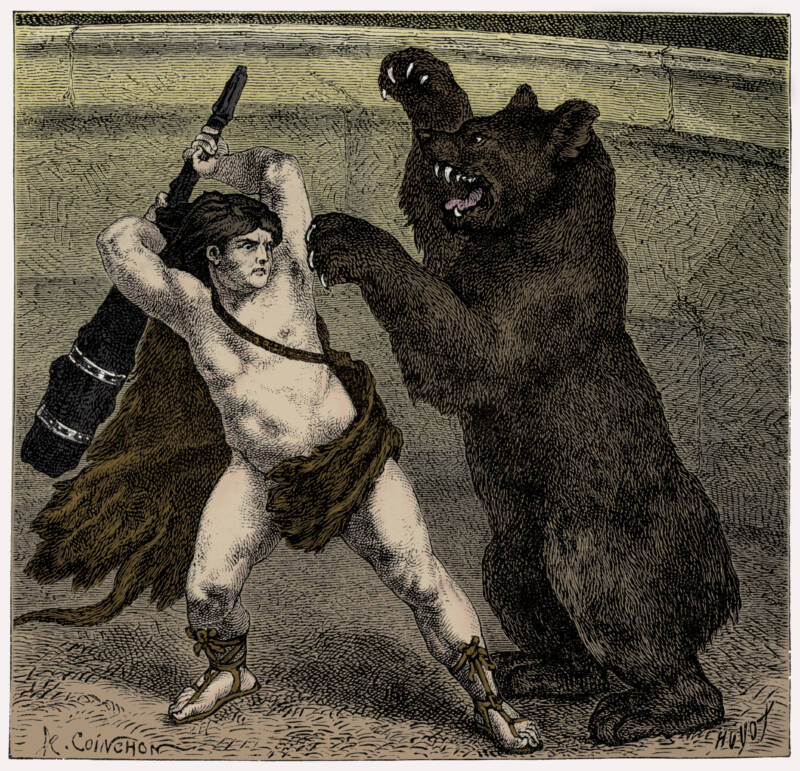Archaeologists found exotic animal remains, seeds, and nuts in the Colosseum's drainage system that give new insight into life in ancient Rome.

Carl Simon/United Archives/Universal Images Group via Getty ImagesRoman gladiator battles were bloody, but they evidently didn’t spoil the appetites of spectators.
For the past year, archaeologists have been conducting a study of the drainage systems beneath the Colosseum in Rome — which has led to the discovery of bone fragments of bears, big cats, and even small dogs.
As Reuters reports, archaeologists also found more than 50 bronze coins from the late Roman period, silver coins commemorating the 10-year anniversary of Marcus Aurelius becoming emperor, various seeds from figs, grapes, and melons, and traces of olives and nuts.
The discoveries allowed researchers to “deepen [their] understanding of the experience and habits of those who came to this place during the long days dedicated to the performances,” said Alfonsina Russo, the director of the Colosseum Archaeological Park.
The seeds and food remnants, for example, likely indicate that the ancient Romans snacked on these foods while spectating matches. Meanwhile, the animal bones are probably from creatures that were used as prey in hunting games or pitted against each other in fights.
According to the BBC, archaeologists navigated the complex drainage system using wire-guided robots. Researchers said that these offered them information about both the daily life of ancient Romans and the hydraulic structures of the time.
The Colosseum fell into disuse around 523 C.E., but this new study is offering a glimpse into its final years.
Altogether, the study involved the clearing of roughly 230 feet of drains and sewers beneath the amphitheater.

Dr. Jo Ball/TwitterAn assortment of the seeds and nuts found in the Colosseum’s drainage system.
Some of the bones found belonged to “sausage dogs,” the ancestors of modern dachshunds. They may have been involved in hunts or fights against bears and other large creatures, but Russo has a less violent hypothesis as well.
“My theory, however,” she said, “is that they were part of a kind of circus act which took place when the gladiators were worn out.”
That said, one of the most popular forms of entertainment in the ancient Colosseum, aside from gladiator battles, was the venatio, a battle involving exotic animals like lions, bears, and hippos.
Often, spectators watched the animals fight each other in the arena. Other times, the animals would be pitted against venatores, warriors with weapons. Venationes were so popular, in fact, that some emperors organized spectacles lasting over 100 days.
Some accounts trace venationes to as early as 252 B.C.E., with one record from Pliny the Elder describing an event involving elephants captured during the First Punic War.
These elephants, it should be noted, were not used in battle — they were displayed for the spectators, most of whom had never seen an elephant before.
Perhaps, then, it was not a true venatio. In that case, the Roman historian Livy might have record of the first event in 185 B.C.E., when Roman general Marcus Fulvius Nobilior staged a hunt to celebrate his victories in Greece.
“For the first time an athletic contest was on at Rome,” Livy wrote. “And a hunt was staged in which lions and panthers were the quarry, and the games were celebrated with practically all the resources and variety that the entire age could muster.”

Culture Club/Bridgeman via Getty ImagesEmperor Lucius Aurelius Commodus dressed as Hercules fighting a bear with a heavy weapon.
Naturally, these were gory events, hence the need for a drainage system that could carry away the blood of animals and men who fought in the arena. Among this waste were, of course, the bones and remnants found in the recent study.
The seeds and nuts were also immaculately preserved in the drains.
“The seeds look like they have just been spat out,” Russo said. “You can imagine Romans taking a basket of fruit to the games then leaving their waste, just as people do now in stadiums. The stands would be washed down by cleaners and we now find the seeds in the drains.”
The only difference between modern spectators and the spectators of old, it seems, is that the sports we now enjoy are generally bloodless — and that’s something to be thankful for.
After reading about these new discoveries beneath the Colosseum, learn about the 1,700-year-old Roman eggs that researchers found — and then cracked open. Or, check out the 1,800-year-old Roman gladiator arena that housed bloody battles in Turkey.





